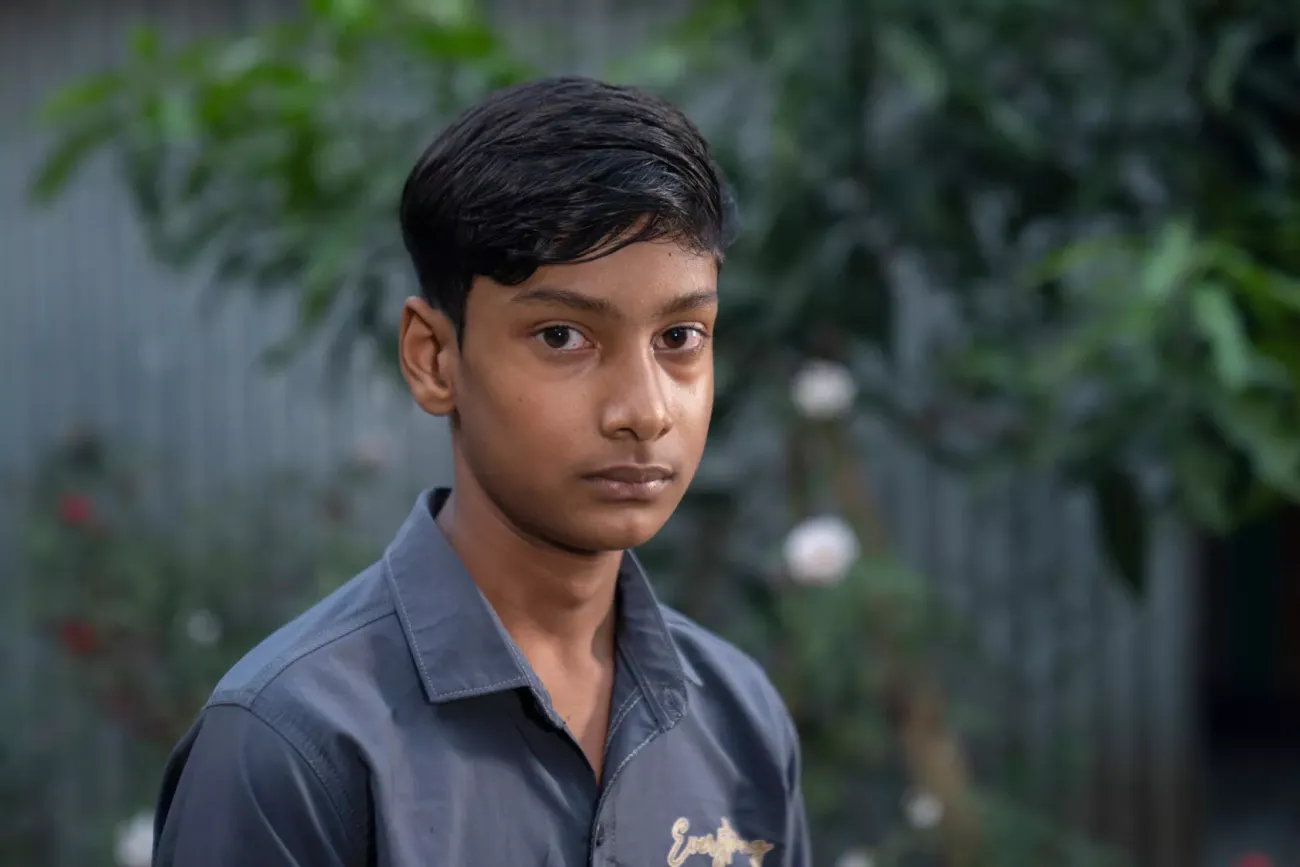Young Mohin’s fight against a silent but fatal adversary

UNICEF helps children and communities battle the deadly effects of lead poisoning in Mirzapur
14 March 2024: In the serene expanse of Mirzapur, Tangail, a stark tale unfolds – one that mirrors the resilience of a community grappling with the unseen perils of lead poisoning.
Gorai in Mirzapur – an area under high threat of lead poisoning – is home to Mohin, a 14-year-old boy studying at the local high school. Mohin tells us the story of how an informal lead-acid battery recycling factory wreaked havoc in his unassuming community, and how he has been helping fight this silent foe with support from UNICEF and its partners.
Unseen dangers
‘Before the battery factory was shut, children used to play in the area regularly, often taking objects like used batteries, pieces of metal and used items home, unaware of the high lead count in them,” Mohin states in an ominous tone.
The effects were not instantly felt in the community, but a lot of the children bringing the items home suffered from headaches and respiratory issues, like coughing and shortness of breath.
“Mohin used to be a healthy boy; but after the smoke of the factory spread in the area, he was ill for a long time. We visited the doctor, carried out all sorts of tests, but nothing came up until very recently. We were shocked when we found out his blood had a 7.97 μg/dL lead count,” says his mother, Morsheda. This level is well above the WHO (World Health Organisation) cut-off value of 5 μg/dL for which an intervention will be required.
The lead poisoning also had adverse effects on the environment in the community. “I heard from the village elders that after the factory was built, the quality of fruits, vegetables and crops which grew readily in our area started deteriorating. Two cows died due to the toxic fumes,” Mohin says. The older people in the community also faced similar difficulties from respiratory problems.
Unveiling the effects
A recent UNICEF-supported Blood Lead Level (BLL) Surveillance study, conducted by the Institute of Epidemiology, Disease Control and Research (IEDCR) in 2022, identified lead in the blood of the 980 children tested in 4 districts, with BLL higher than 5 µg/dL among 40% of them.
The number of children affected is about 35 million in Bangladesh alone and according to the Institute of Health Metrics Evaluation, Bangladesh has the world's fourth-highest rate of death due to lead exposure.
Lead exposure poses a severe public health crisis, even at low levels in the bloodstream. It triggers headaches, abdominal pain, memory issues, poor concentration, and impacts neurological functions, causing restlessness or fatigue.
Beyond its immediate impact on children's physical and mental growth, lead significantly disrupts their education, performance at school, health, overall well-being, and future potential. This pervasive threat lingers long-term, necessitating urgent action through intervention and prevention measures to safeguard children's health and secure a brighter future for generations to come. In addition, adults suffer from cardiovascular diseases, especially pregnant women, who risk having preterm babies, or spontaneous abortion due to lead poisoning.
Championing change
Amidst the lead pollution crisis and its devastating impact, UNICEF, in partnership with Pure Earth, has played a pivotal role in providing both technical and financial support to the Directorate General of Health Services (DGHS) under the Ministry of Health and Family Welfare (MOHFW) – primarily through the Protecting Every Child’s Potential (PECP) initiative, spanning from late 2020 to June 2023, and the ongoing Healthy Environments for Healthy Children (HEHC) programme since July 2023.
UNICEF support encompasses a comprehensive array of efforts, including program design, research, monitoring, policy development and review, capacity building, advocacy, and social behaviour change communication activities; efforts that aim to effectively prevent and manage lead poisoning at a national level, fortifying Bangladesh's strategies in safeguarding children's health and well-being.
UNICEF has also supported the development of a national clinical guideline on lead poisoning management and a training module on lead poisoning, further developing a resource pool of 35 health and education professionals as trainers to conduct cascade training at national and local/district level. As of December 2023, 648 healthcare professionals, including doctors, nurses, midwives, and paramedics, as well as 538 teachers, have been trained and sensitized by these trainers to disseminate lead poisoning prevention measures in their local schools and communities.
Empowering the community
Mohin has learned from the teachers at his school how lead can find its way to the human body, what harms it may cause, what everyday objects are high in lead content and how to avoid the negative effects.
“Our teachers said that lead could be found in everyday items like shiny utensils, children’s toys, batteries, paint and even in some food items. They instructed us to stay away from these things,” he said.
The soft-spoken adolescent feels empowered now as he shares his knowledge about lead poisoning acquired from the school with his peers, neighbourhood kids and other stakeholders. He has managed to inform many youngsters in his community about the seriousness of lead poisoning and taught them how to avoid the deadly disorder.
“After I spoke about the ill effects of lead poisoning to my friends, they now understand the significance of this disease. I now know that when we share our knowledge, we can all work together to defeat lead poisoning.”
- Mohin, 14
Mohin's efforts keep bringing change to his community, buoyed by UNICEF's unwavering support in spreading awareness and helping implement crucial interventions. UNICEF is helping the Government of Bangladesh to amplify voices through collaborative initiatives, providing essential resources and educational tools to empower not only individuals but also entire communities in their steadfast fight against lead poisoning.






